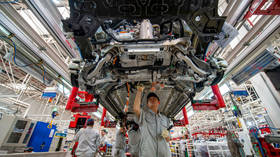D’Oh! 1 in 4 Americans don’t know Earth circles Sun

The nation that put the first man on the Moon is failing to make the grade today when it comes to basic knowledge of the solar system and other fundamental scientific insight.
That’s according to a new survey which concludes that while most
Americans have a world of information at their fingertips, and
show tremendous enthusiasm for new technology, they also lack
fundamental knowledge of basic science.
Out of a total of nine questions on subjects related to physical
and biological sciences, the average score in the survey was a
narrowly passing 6.5 correct answers, according to a survey of
2,200 Americans conducted by the National Science Foundation. The
result was announced at the annual meeting of the American
Association for the Advancement of Science, held Friday.
For example, only 74 percent correctly answered that the Earth
revolved around the Sun.
In 1543, the astronomer Nicolas Copernicus shattered the long-held view that Earth was the center of the universe when he put forth a heliocentric model of the universe where all planetary objects, including the Earth, revolved around the Sun.
Meanwhile, fewer than half (48 percent) of study participants
were aware that human beings evolved from earlier species of
animals, the celebrated scientific nostrum first demonstrated by
British naturalist Charles Darwin in his 1859 book, “On the
Origin of Species.”
That is despite the United States’ apparent fondness for
so-called "informal science education." The survey has
revealed that almost 60 percent of Americans have visited at some
point a zoo, natural history museum or a science and technology
museum.
According to the test, more than 90 percent of Americans are of
the opinion that scientists are "helping to solve challenging
problems" and are "dedicated people who work for the good of
humanity."
Also, nearly 90 percent said the benefits of science
outweigh any of its potential dangers, and about the same number
expressed interest in learning about medical discoveries.
"It's important for Americans to maintain a high regard for
science and scientists," according to John Besley, an
associate professor in Michigan State University’s Department of
Advertising and Public Relations. "It can help ensure funding
and help attract future scientists."
The full findings of the survey, which is conducted every two
years, will be included in a National Science Foundation report
to President Barack Obama and lawmakers in Congress.
The question of academic quality has become a hot political issue
as a number of international tests show Americans falling behind.
A recent study by the Organization for Economic
Cooperation and Development showed that Americans scored far
below average and higher than only two of 12 other developed
comparison countries, Italy and Spain.
The US’s failure to keep academic pace with the rest of the
world, which could have serious implications for the country’s
future economic performance, has led to many questioning the
quality of the public school system in general and teachers in
particular.
The National Council of Teacher Quality recently called America’s
teacher preparation programs “an industry of
mediocrity,” ranking just 10 percent of more than 1,200 of
them as high quality, while most have low or no academic
standards for entry.
Critics also point to the fact that American school districts
rely heavily on property taxes for their funding, which means
schools in affluent areas get more cash than those in middle and
poor ones. Tax money to fill the void fails to make ends meet in
school districts where poverty levels are greatest.














